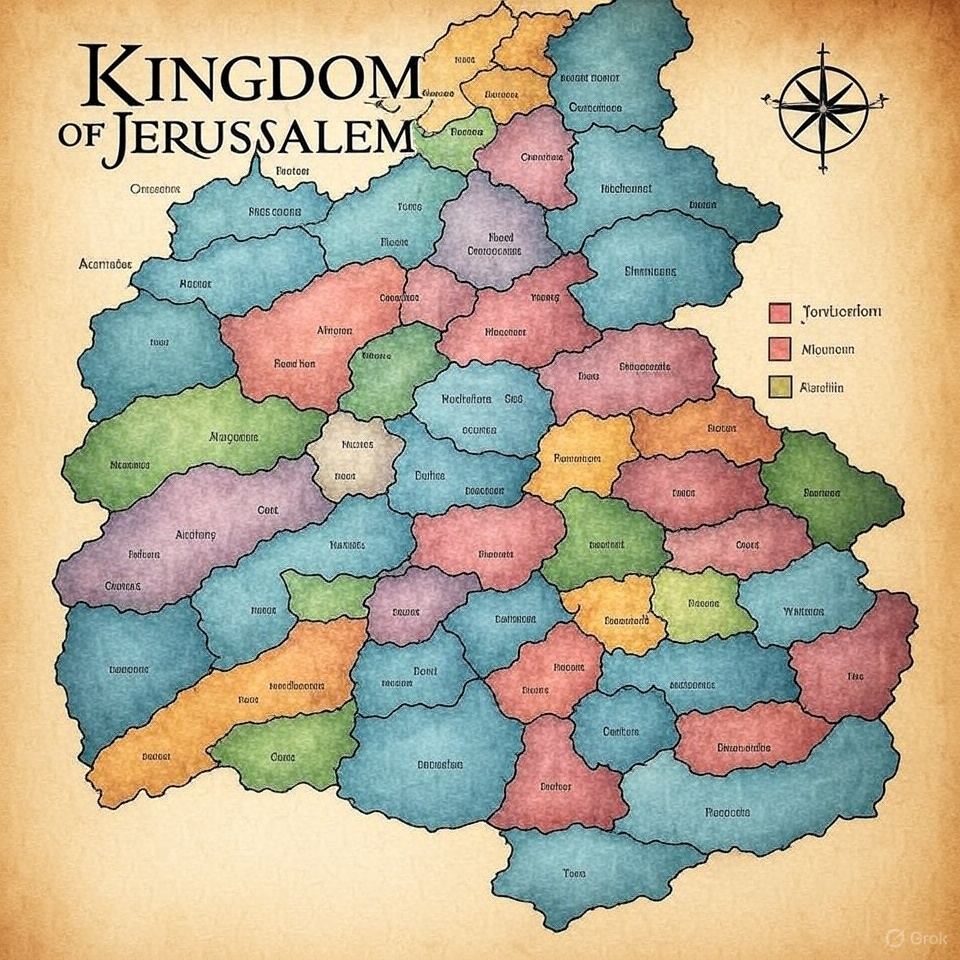Imagine a scorching summer day in 1099, the air thick with dust and the clamor of battle. On July 22, a moment unfolded that would ripple through the centuries, altering the course of history and offering lessons that resonate even now, in 2025. This is the story of Godfrey of Bouillon, a humble yet formidable leader who, on this very date, was elected the first Defender of the Holy Sepulchre in the newly established Kingdom of Jerusalem. It’s a tale of grit, faith, and triumph from the distant past—over 900 years ago—during the First Crusade. More than just a historical milestone, it’s a source of inspiration, a call to action, and a blueprint for navigating the challenges of today. In this blog, we’ll dive deep into the gritty details of this event, explore its medieval context, and uncover how its echoes can motivate and guide us in our modern lives. Buckle up for an educational, fun, and motivational journey through time!
—
## The First Crusade: A Grand and Perilous Quest
To grasp the weight of July 22, 1099, we need to rewind a few years to 1095, when the seeds of this monumental event were sown. It all began at the Council of Clermont, where Pope Urban II issued a rallying cry that would ignite one of the most ambitious expeditions of the Middle Ages: the First Crusade. His goal? To reclaim Jerusalem, the holiest city in Christendom, from Muslim control. This wasn’t just a military campaign—it was a spiritual quest that drew thousands of knights, peasants, and pilgrims from across Europe, united by faith, ambition, and the promise of glory.
The Crusade kicked off in 1096, and it was no walk in the park. The journey spanned over 2,000 miles for some, crossing rugged terrain from France, Germany, and Italy to the heart of the Holy Land. Armies faced starvation, disease, and relentless skirmishes with hostile forces. The People’s Crusade, an early wave of poorly organized pilgrims, was decimated by the Seljuk Turks in Anatolia. Yet, the main Crusader forces—led by seasoned nobles like Godfrey of Bouillon, Raymond of Toulouse, and Bohemond of Taranto—pressed on.
By 1097, they’d scored a major victory at Nicaea, handing the city back to the Byzantine Empire. Then came the brutal siege of Antioch in 1098, a grueling eight-month ordeal that tested their endurance. Starvation drove some to desertion, and rumors of cannibalism swirled among the ranks. But Antioch fell, and the path to Jerusalem lay open. After three years of hardship, the Crusaders stood before their ultimate prize in June 1099, weary but resolute.
—
## The Siege of Jerusalem: Blood, Sweat, and Victory
On June 7, 1099, the Crusaders encircled Jerusalem, a city perched atop a plateau, its towering stone walls a formidable barrier. Inside, a garrison of Fatimid soldiers and a diverse population—Muslims, Jews, and Christians—braced for the onslaught. The Crusaders numbered around 12,000, a fraction of the 40,000 who’d set out years earlier, their ranks thinned by battle and attrition. They faced a daunting task: breach the defenses with limited resources under a blazing sun.
The first assault was a disaster. Lacking proper siege equipment, the Crusaders relied on hastily built ladders and sheer determination. The defenders repelled them with arrows, boiling oil, and stones. Water was scarce—the nearest spring was miles away—and the heat sapped their strength. But ingenuity prevailed. Timber arrived from ships dismantled at Jaffa, and the Crusaders constructed two massive siege towers, along with catapults and battering rams.
On July 13, the tide turned. Godfrey of Bouillon positioned his tower on the northern wall, near Herod’s Gate. Under a barrage of projectiles, his men rolled it into place. On July 15, after a relentless two-day assault, they broke through. Godfrey himself was among the first to scale the wall, his banner unfurling over the battlements. Raymond’s forces breached the southern defenses soon after. Jerusalem fell, and what followed was a grim massacre—tens of thousands of inhabitants slain in a frenzy of violence that stained the Crusaders’ triumph.
Yet, amidst the chaos, a new order was about to rise from the ashes of conquest.
—
## Godfrey of Bouillon: The Reluctant Ruler
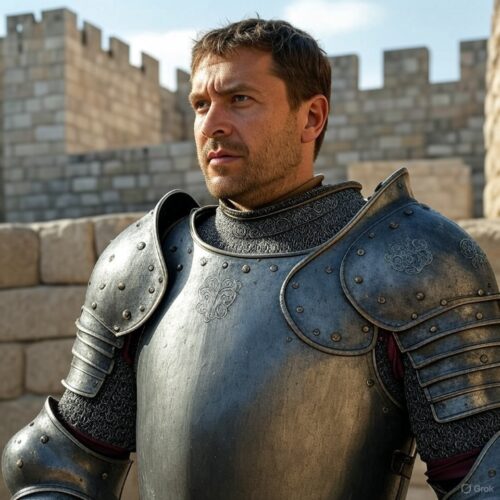
With Jerusalem secured, the Crusader leaders faced a critical decision: who would govern this sacred land? On July 22, 1099, their choice fell on Godfrey of Bouillon, a noble from the Duchy of Lower Lorraine. Born around 1060, Godfrey was no stranger to leadership. He’d sold his estates to fund the Crusade, proving his commitment, and his valor during the siege had earned him widespread respect.
Godfrey stood out among his peers. Tall and broad-shouldered, with a reputation for piety and courage, he embodied the ideal of a Christian knight. Yet, he wasn’t driven by greed or power lust like some counterparts—Bohemond, for instance, had stayed in Antioch to carve out his own domain. When offered the crown of Jerusalem, Godfrey’s response was striking. “I will not wear a crown of gold where Christ wore a crown of thorns,” he declared, rejecting the title of king. Instead, he accepted a humbler role: *Advocatus Sancti Sepulchri*, or Defender of the Holy Sepulchre.
This wasn’t just humility—it was a statement. Godfrey saw his duty as safeguarding the Church of the Holy Sepulchre, the site of Christ’s tomb, rather than ruling as a monarch. His election on July 22 marked the birth of the Kingdom of Jerusalem, a fledgling state in a hostile region. He swore to protect its Christian inhabitants and ensure safe passage for pilgrims, setting a tone of service over sovereignty.
—
## The Kingdom of Jerusalem: A Fragile Foothold
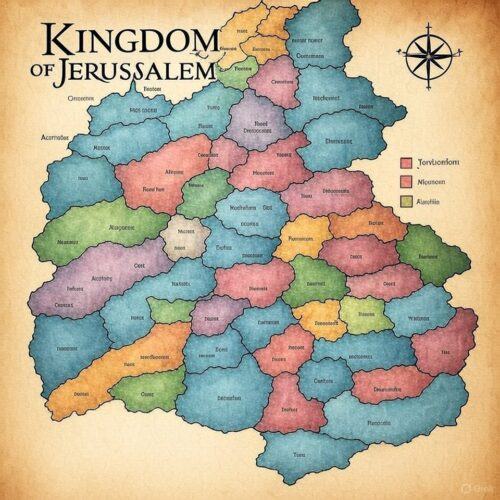
The Kingdom of Jerusalem, formalized on that fateful July day, was a patchwork of conquered territories stretching from Jaffa to the Jordan River. It was a feudal state, blending European traditions with the realities of the Levant. Godfrey wasted no time organizing its defenses. He faced immediate threats—Fatimid forces from Egypt were already mobilizing to reclaim the city. In August 1099, he led a decisive victory at Ascalon, securing Jerusalem’s southern flank.
Godfrey’s reign was brief but foundational. He established a council of nobles to govern, levied taxes to fund the military, and negotiated with local Christian and Muslim communities. His laws aimed to balance the needs of the Crusader settlers—knights, merchants, and clergy—with the diverse population they now ruled. He also fortified key sites, like the Tower of David, to protect against future sieges.
Tragically, Godfrey’s time was cut short. He fell ill in July 1100, possibly from typhoid or poisoning, and died at age 40. His brother, Baldwin I, succeeded him, taking the title of king and expanding the kingdom’s reach. Under Baldwin and his successors, the Kingdom of Jerusalem endured for nearly two centuries, a testament to the groundwork laid on July 22, 1099. It became a hub for trade, religion, and culture, though always teetering on the edge of collapse amid constant wars with Muslim powers like the Zengids and Ayyubids.
This event wasn’t just the creation of a kingdom—it was a bold experiment in governance, faith, and survival in a land far from home.
—
## The Siege That Shaped Jerusalem: A Closer Look
Let’s zoom in on the siege itself, because the details reveal the raw human drama behind July 22. The Crusaders arrived ill-equipped—most of their siege engines had been lost or abandoned en route. They scavenged wood from olive groves and dismantled their own camps for materials. The siege towers, towering over 50 feet, were engineering marvels under the circumstances, lashed together with ropes and hides to withstand enemy fire.
Godfrey’s northern assault was a masterstroke. He feigned attacks on other walls to confuse the defenders, then struck at dawn on July 15. His men used a drawbridge from the tower to cross onto the ramparts, fighting hand-to-hand with swords and axes. The defenders, stretched thin, couldn’t hold the line. Meanwhile, Raymond’s southern breach exploited a weaker section of wall, collapsing it with a ram. The coordination was imperfect—communication relied on horns and flags—but it worked.
The aftermath was chaotic. Chroniclers like Raymond d’Aguilar described streets “piled with bodies,” a grim toll of victory. Yet, the Crusaders saw it as divine will, a fulfillment of their vow. The election of Godfrey a week later was a deliberate shift from bloodshed to stability, a moment of reflection amid the storm.
—
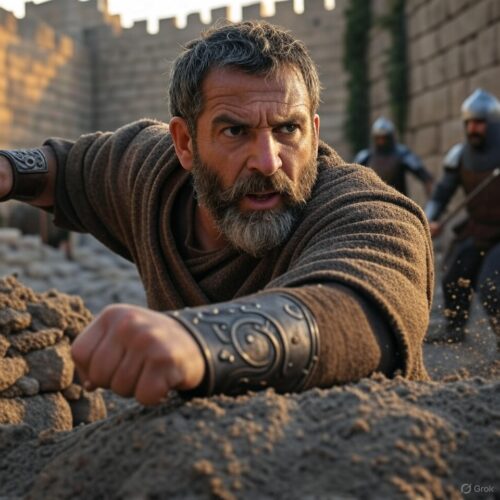
## Why It Matters: The Big Picture
The establishment of the Kingdom of Jerusalem on July 22, 1099, was a turning point in medieval history. It solidified the Crusaders’ presence in the Holy Land, sparking a series of subsequent Crusades—eight major ones over the next 200 years. It also deepened the divide between Christendom and the Islamic world, fueling centuries of conflict and cultural exchange. The kingdom’s existence reshaped trade routes, bringing European influence to the Levant and vice versa—spices, silks, and ideas flowed back to the West.
For Europe, it was a proving ground. The success of the First Crusade boosted the prestige of the Church and the feudal nobility, inspiring tales of chivalry that echoed in literature like the *Chanson de Roland*. For the Middle East, it was a disruption, a foreign enclave that challenged the dominance of Muslim empires like the Fatimids and later the Seljuks.
Godfrey’s role, though short-lived, was pivotal. His humility and focus on duty over power set a precedent for leadership in a region where ambition often led to ruin. The kingdom he founded outlasted him by generations, a fragile but enduring legacy of that July day.
—
## A Hidden Gem: The Siege of Belgrade, July 22, 1456
While we’re on the topic of July 22, let’s unearth a lesser-known gem from history: the Siege of Belgrade, which began on this date in 1456. Far from Jerusalem, in the heart of Europe, the Ottoman Empire under Sultan Mehmed II—the conqueror of Constantinople—set its sights on Belgrade, a key fortress on the Danube. Standing in their way was John Hunyadi, Regent of Hungary, a grizzled warrior with a knack for defying the odds.
Mehmed rolled up with an army of 60,000, backed by cannons and a fleet of ships. Hunyadi had maybe 20,000 men, a mix of professional soldiers, peasants, and Crusader volunteers rallied by the fiery preacher John of Capistrano. The Ottomans bombarded the walls for weeks, but Hunyadi struck back with a daring counterattack on July 22. His forces broke the siege, sinking Ottoman ships and routing their camp in a chaotic melee.
This victory wasn’t just a military upset—it stopped the Ottoman advance into Europe for decades, buying time for the West to regroup. Bells rang across Christendom to celebrate, a tradition some say inspired the noon bell still heard today. Yet, this epic stand remains overshadowed by flashier battles like Constantinople’s fall. It’s a raw, gritty tale of grit and unity—perfect fodder for a future blog!
—
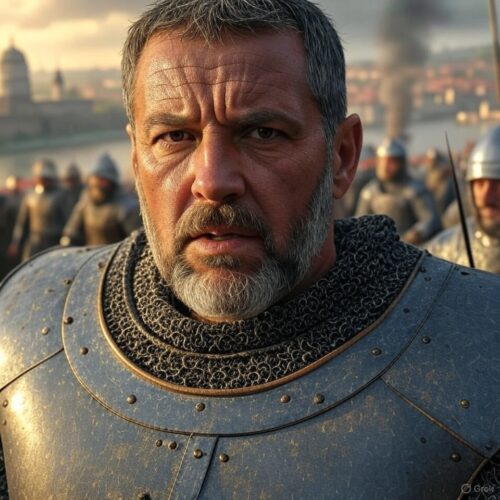
## Lessons from 1099: History’s Gifts to Today
Now, let’s shift gears. The story of Godfrey and July 22, 1099, isn’t just a dusty relic—it’s a treasure chest of wisdom for 2025. Here’s how this medieval saga can light a fire under us:
– **Humble Leadership**: Godfrey ditched the crown for a servant’s role. In a world obsessed with titles, leading with humility can make you a standout.
– **Unity in Diversity**: The Crusaders were a motley crew—French, Normans, Germans—yet they pulled together. Diversity, harnessed right, is a superpower.
– **Resilience**: Three years of hell didn’t break them. Whatever you’re facing, endurance can carry you through.
– **Purpose-Driven Life**: Faith fueled Godfrey. Find your “why,” and it’ll steer you through chaos.
– **Strategic Smarts**: The siege wasn’t luck—it was planning. Think ahead, and you’ll win more than you lose.
—

## Your Plan: Living the Legacy of July 22
Ready to make history work for you? Here’s a concrete, actionable plan to channel 1099 into your life today:
- **Lead with Humility**
– **Action**: Take on a leadership role—maybe at work or in a volunteer gig—and prioritize the team’s success over your own spotlight. Mentor someone instead of showing off.
– **Benefit**: You’ll earn loyalty and respect, building a network that lifts everyone up.
- **Harness Diversity**
– **Action**: Join a group or project with people unlike you—different skills, cultures, whatever. Collaborate on something big, like a community event.
– **Benefit**: Fresh ideas will spark creativity, and you’ll grow skills you didn’t know you needed.
- **Bounce Back Strong**
– **Action**: Pick a tough goal—say, mastering a language or running 10K. When you stumble, log what went wrong and tweak your approach.
– **Benefit**: You’ll forge a steel spine, ready for life’s curveballs.
- **Anchor in Purpose**
– **Action**: Spend 10 minutes daily reflecting on what drives you. Write it down—career dreams, family, a cause. Align one task each day with it.
– **Benefit**: Clarity will cut through distractions, keeping you fired up and focused.
- **Plan Like a Crusader**
– **Action**: Map out your next big move—job switch, side hustle, whatever. List steps, risks, and backups. Review it weekly.
– **Benefit**: You’ll dodge chaos and hit your targets with precision.
Start small, but start now. These steps turn history into horsepower for your life.
—
## The Final Charge: History as Your Ally
July 22, 1099, wasn’t just a dot on a timeline—it was a clash of wills, a birth of a kingdom, and a spark that still glows. Godfrey of Bouillon didn’t just defend a tomb; he built a legacy of courage and conviction. The Siege of Belgrade in 1456 echoes the same vibe—ordinary folks rising to extraordinary feats. These stories prove that the past isn’t dead—it’s a mentor, whispering strategies for today.
So, as you sip your coffee on this July 22, 2025, think of Godfrey scaling those walls, of Hunyadi staring down an empire. Let their valor push you to lead better, fight harder, and live bolder. History’s not just for books—it’s for you. Grab its lessons, charge into your day, and make your own mark. The echoes of 1099 are calling—will you answer?

